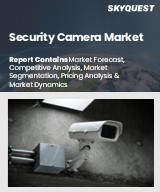
Report ID: SQMIG25E2175
SkyQuest Technology's Security camera market size, share and forecast Report is based on the analysis of market data and Industry trends impacting the global Security Camera Market and the revenue of top companies operating in it. Market Size Data and Statistics are based on the comprehensive research by our Team of Analysts and Industry experts.
Global Security Camera market size was valued at USD 35.43 Billion in 2023 and is poised to grow from USD 39.25 Billion in 2024 to USD 89.17 Billion by 2032, growing at a CAGR of 10.8% during the forecast period (2025-2032).
The primary force currently driving the market for global security cameras is the increased concern for public safety as well as urbanization and technological advances. These forces are complemented by new technologies such as high-definition imaging and night vision, which can be additionally augmented with thermal imaging and AI analytics, to enhance the efficiency of surveillance systems.
Driving all of this is a proliferation of security cameras that are increasingly equipped with artificial intelligences and machine learning capabilities for facial recognition, behavior analysis, or automated alerting, making preemptive threat detection and incident management more effective. The trend is also toward going completely wireless or cloud-based, which offers flexibility and scalability, making very complex surveillance systems much more affordable and possible for a larger audience.
Adopting AI and Machine Learning for use in security cameras might be one of the major drivers for the developments in this equipment, including the importance of facial recognition, analysis of behavior, and automatic alerts. This eventually leads to detection and management of threats proactively. At the same time, thanks to their mobility and scalability, wireless and cloud-based systems prove cost-effective to almost every class of user
Why Are Cloud-Based Surveillance Solutions Gaining Momentum?
Cloud-based surveillance is the new trend that not only organizations, but also individual consumers will experience in the management of security infrastructures. With such systems, users can remotely access live and recorded video footage through mobile apps or web platforms with improved response times and situational awareness. Deployment is actual and easy because it absolutely eliminates the hassle of managing complicated on-premises servers that suit small enterprises, retail chains, and home users. But there's more, as cloud platforms provide features such as automated updates, end-to-end encryption, and even analysis by artificial intelligence, all of which add up to an environment that is much smarter and more secure for surveillance.
For example, a portable wireless camera, the Ulticam Dot, packed with seven days of free cloud storage and plug-and-play installation, was launched in early 2025 by Xthings. It signals that the market is gradually moving toward systems that are smaller, more scalable, and easier to use. It is expected that, with improvements in internet bandwidth everywhere, cloud-based surveillance will soon become most important in the future infrastructure of smart cities and connected homes.
REQUEST FOR SAMPLE
Global Security Camera market size was valued at USD 35.43 Billion in 2023 and is poised to grow from USD 39.25 Billion in 2024 to USD 89.17 Billion by 2032, growing at a CAGR of 10.8% during the forecast period (2025-2032).
To remain competitive in the Security Camera market, key players emphasize AI-based video analytics, edge computing, and seamless cloud integration. Companies are forming strategic alliances to accelerate innovation and market penetration. Enhanced cybersecurity features and region-specific product customization are gaining importance to meet regulatory and customer demands. Investments in real-time monitoring and smart detection capabilities further drive differentiation and long-term growth across diverse market segments. 'Honeywell International Inc.', 'Cisco Systems, Inc.', 'Panasonic Holdings Corporation', 'Robert Bosch GmbH', 'Teledyne FLIR LLC', 'Milesight', 'Dahua Technology Co., Ltd.', 'Swann Communications Pty. Ltd', 'Arlo Technologies Inc', 'Axis Communications AB (Canon Inc.)', 'Eagle Eye Networks', 'Spot AI', 'Rhombus Systems', 'Wyze', 'Hikvision Digital Technology Co., Ltd.', 'Avigilon', 'Hanwha Vision (Hanwha Techwin)', 'Uniview Technologies Co., Ltd.', 'Vivotek Inc.', 'Verkada'
Retail and hospitality chains are rapidly scaling camera installations to meet stringent compliance norms around data security, loss prevention, and workplace safety. For instance, in 2023, Walmart expanded its AI-based surveillance coverage across over 4,700 U.S. stores to comply with OSHA guidelines and to tackle $3 billion in annual shrink losses. Similarly, Marriott integrated advanced surveillance tech in over 500 properties globally to meet GDPR and regional guest safety regulations. Regulatory pressure combined with brand protection mandates is now a strategic driver, especially across developed markets.
Short-Term: AI-integrated cameras are rapidly enhancing urban surveillance. At the 2024 Paris Olympics, over 200 AI cameras from Wintics monitored public spaces, detecting anomalies in real-time. Dahua and Hikvision also rolled out facial recognition-enabled models. Governments are increasingly adopting these technologies for crowd control and crime prevention. However, the push for public safety is sparking debates around data privacy and AI ethics, prompting calls for stricter regulatory frameworks.
Why is Demand for Security Cameras Fueling Growth in North America?
Want to customize this report? This report can be personalized according to your needs. Our analysts and industry experts will work directly with you to understand your requirements and provide you with customized data in a short amount of time. We offer $1000 worth of FREE customization at the time of purchase.
Feedback From Our Clients

Report ID: SQMIG25E2175
sales@skyquestt.com
USA +1 351-333-4748